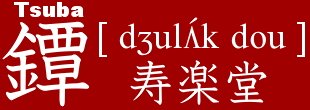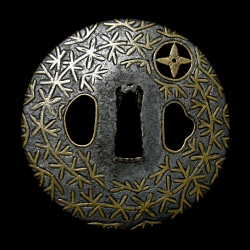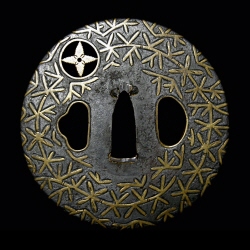Yoshiro-Shiki Shinchu-Zogan-Tsuba

-
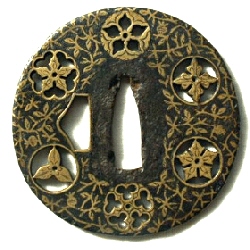
- [ Yoshiro-Shiki Shinchu-Zogan Tsuba ]
The Momoyama period or
Early part of the Edo period (estimate)
Yoshiro-Shiki Shinchu-Zogan Tsuba is affiliated with Heianjo-Shiki Shinchu-Zogan Tsuba. However, Yoshiro-Shiki were made with much advanced
techniques. It is more elaborate than Heianjo-Shiki.
We call this type of tsuba "Yoshiro-Shiki Shinchu-Zogan Tsuba" because the craftsman "Yoshiro" is the most representative of this type of tsuba.
Several sword guards inscribed "Yoshiro" are existing.
His full name is Koike Yoshiro Naomasa.
Toyotomi Hideyoshi (1536-1598) who unified Japan gave a title "Tenkaichi" (=Number One in the World) to him.
Yoshiro called himself "Izumino-Kami" rank.
As Yoshiro-Shiki Shinchu-Zogan Tsuba is descended from Heianjo-Shiki Shinchu-Zogan Tsuba, they were mostly produced in Yamashiro Province (=Now Kyoto Prefecture).
We can also find this kind of tsuba in Kaga Province (=Now Ishikawa Prefecture) and Bizen Province (=Now Okayama Prefecture).
-
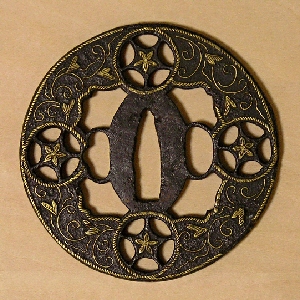
- [ Yoshiro-Shiki Shinchu-Zogan Tsuba ]
The Momoyama period (estimate)
It is generally believed that Yoshiro-Shiki Tsuba catched on big from the Momoyama period (1573-1603) to the early part of the Edo period (1603-1868).
Arabesque, Flowers and family crests were inlaid with brass on thin forged iron plates.
And, several parts were openworked like transom windows of which we
can see in Japanese temples or shrines. This technique is called "Ranma-Bori"
(=carving like transom window).
At the latter part of the Edo period, sometimes they used Shakudo
(alloy of copper and gold) instead of iron, or used gold, silver or
Shakudo as the materials of inlay instead of brass.
-


- [ Family Crests & Algae ]
No Inscription, by Koike Yoshiro
The Momoyama period (1573-1603)
